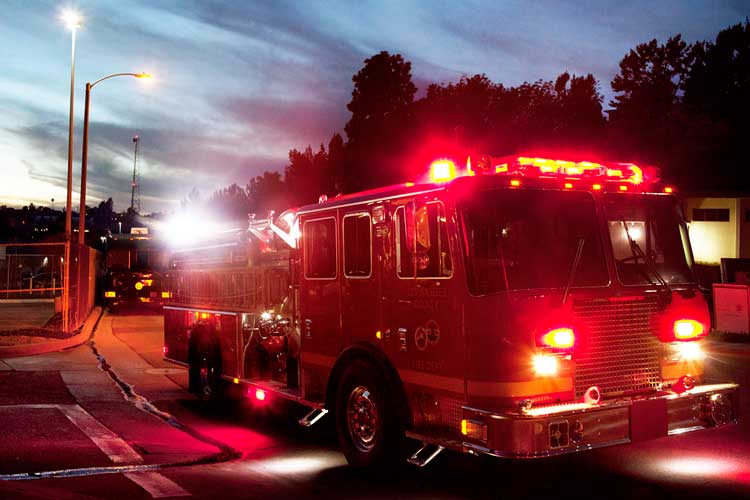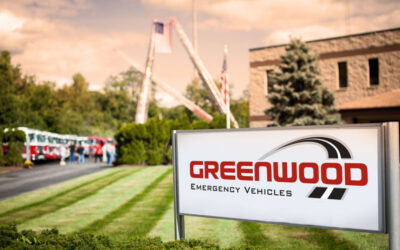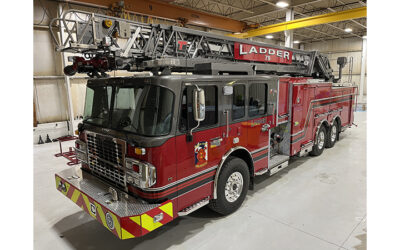By Bill Adams
Glare Phenomena
Lately the fire service, warning light manufacturers, pundits, commentators, and safety gurus alike have advocated doing something about the glare or distraction of warning lights that people say can, could, may, or might be a cause or a contributing factor of accidents. Fire apparatus parked with their warning lights on in the blocking-the-right-of-way mode are being rammed with a degree of regularity—some tragically so.
Related Content
The accidents are not restricted to fire apparatus. Law enforcement vehicles, tow trucks, ambulances, and highway maintenance vehicles have also been struck. Some claim the major culprit is the intensity of or possibly the flash rates of LED warning lights. Nobody really knows. Everyone’s opinions are just theories, speculation, and guesswork. Definitive testing hasn’t been done. No scientific evidence says this light or that light causes accidents. Nor can anyone say it is the flash rate, pattern, or color of the lights.
Informal testing has been conducted or sanctioned by warning light manufacturer(s). That raises a red flag. While intentions are admirable, there is a possibility of bias. Manufacturers shouldn’t place themselves in the unenviable position of being accused of selling product under the guise of promoting safety when conducting or even supervising testing. All testing, regardless of who is doing it or where it is conducted, should be done publicly. There shouldn’t be testing in secret and then publishing a report afterward offering to save the world. That’s not right.
It is no different than witnessing a third-party fire pump certification test or an aerial ladder test. It is commendable fire departments and regional fire service organizations attempt to evaluate lighting in localized settings. However, they may not have the sophisticated equipment or a defined set of testing criteria to evaluate the lights. There is value and integrity when testing is conducted by an independent and unbiased third-party entity.
SAE
National Fire Protection Association (NFPA) 1901, Standard for Automotive Fire Apparatus, Chapter 2 references publications in the Standard that “shall be considered part of the requirements” of the document.” Twenty-eight specific SAE International (SAE) publications are mentioned. What is the SAE, and what does it have to do with fire trucks and, in particular, a rig’s warning lights?
Paraphrasing various SAE Websites,“SAE International, previously known as the Society of Automotive Engineers, is a U.S. based global professional association and standards developing organization for engineering professionals in various industries. Founded in 1905, it provided an umbrella organization for automotive engineers located in various parts of the country. Henry Ford was a founding member. Today, SAE calls itself “a non-profit, educational and scientific organization dedicated to advancing, developing and promoting aerospace, commercial vehicle and automotive engineering.”
I venture that in 1905 the SAE ensured calculating the horsepower of an Auburn would be the same as calculating it for an Austin, and the testing criteria used to determine the speed of a Franklin was the same used on a Fredonia. In simple terms, the SAE establishes benchmarks ensuring all players in a designated field abide by the same rules and conduct tests the same way and ensures the methods to gauge performance levels are consistent. The SAE is apolitical. Manufacturers do not belong to it. Membership is restricted to individuals.
Ken Menke’s Proposal
Ken Menke III, the owner of the Missouri based warning light manufacturer PowerArc, is an excellent source for technical information for lighting. I describe him as an encyclopedic technocrat who bases everything on scientifically proven testing. He has sat on the SAE’s Emergency Warning Lights and Devices Standards Committee (EWLD) for more than 20 years. There are about 100 members on it.
He spearheaded a proposed “SAE Emergency Warning Lights and Devices LED Conspicuity and Glare Study.” The short version of the story is he approached the EWLD with the idea to address the issue of glaring warning lights. It was discussed and a draft proposal was made, voted on, and approved.
Intriguingly, all the players who have demonstrated or expressed an interest in warning light glare have been notified of it. Included are the NFPA, the Fire Apparatus Manufacturers’ Association, the National Highway Transportation Safety Association, the Emergency Responder Safety Institute, the General Services Administration, the Federal Emergency Management Agency, the Department of Homeland Security, the U.S. Department of Justice, the Office of Justice Programs, International Fire Chiefs, the International Fire Service Training Association, the United States Fire Administration, the National Volunteer Fire Council, the Cumberland Valley Volunteer Firemans’s Association, the International Association of Chiefs of Police, the National Sheriffs Association, the Fire Department Safety Officers Association, the International Association of Fire Chiefs, the International Society of Fire Service Instructors, the Metropolitan Fire Chiefs Association, the National Volunteer Fire Council, the Association for the Work Truck Industry, the National Institute of Standards & Technology, the National Transportation Standards Association, the National Institute for Occupational Safety and Health, the National Association of State EMS officials, and CAAS Ground Vehicle Standards.
According to Menke, members of the SAE Lighting Committee affiliated with warning light manufacturers who were in attendance worked on and voted on the proposed SAE study. They include Federal Signal, Soundoff Signal, Weldon/IDEX, Code 3/ECCO, PowerArc, Star Headlight and Lantern, Whelen, Superior Signal, and North American Signal.
The SAE’s scientific approach is to address the “observable field phenomenon of glare” by adopting a consensus method to conduct testing that will be publicly available for review. It should insure objectivity without bias—a big plus for to the fire service and warning light industry. There will be more on it later.
BILL ADAMS is a member of the Fire Apparatus & Emergency Equipment Editorial Advisory Board, a former fire apparatus salesman, and a past chief of the East Rochester (NY) Fire Department. He has 50 years of experience in the volunteer fire service.






